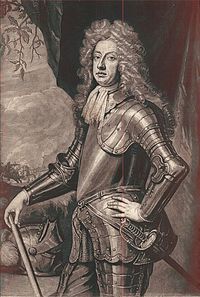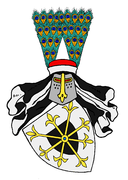House of Schomberg
Schönberg | |
|---|---|
| Parent house | Schönburg auf Wesel |
| Country | United Kingdom |
| Place of origin | Rhineland |
| Founded | 1672 |
| Founder | Frederick Schomberg, 1st Duke of Schomberg |
| Titles | King of the United Kingdom of Great Britain Duke of Schomberg Duke of Leinster Marquess of Harwich Earl of Brentford Earl of Bangor Baron Teyes Count of Mertola |
The House of Schomberg ([ʃɔmbəː(ɹ)g]; German: Schönburg, Norwegian: Skjønnberg), is a reigning European royal house of Huguenot, English, Scottish, and Rhenish origin that has ruled the United Kingdom of Great Britain since 1777 and previously Norway from 1815 to 1843.
Members of the dynasty trace their descent back to Count Hans Meinhard von Schönberg, a 16th-century nobleman of the Electoral Palatinate. In 1672, his son, Frederick Schomberg, was invited to London by Henrietta I to take command of a contingent of the English Army. After the decisive defeat of France by a coalition of England, the Netherlands, and Spain in 1676, the Schomberg family settled in Middlesex. By 1700, the Schombergs had acquired numerous British titles and properties, thus firmly establishing themselves as British nobles.
In 1777, with the death of the Stuart-Nassau queen Elizabeth II, the majority of the British Parliament threw their support behind Frederick Schomberg as successor due to his seventh-generation descent from James VI & I of Scotland, England, and Ireland through his grandmother Princess Louise Apollonia of Salm and great-grandmother Raugravine Caroline Elisabeth.
History
The Schomberg dynasty arises from an old Rhenish noble family, Schönburg auf Wesel. Schönburg Castle in the town of Oberwesel has been the ancestral seat of the family since the 12th century. Several distinct lines of the family were living at the Castle throughout the 1500s. This Schomberg family is not to be confused with the Saxon-Thuringian noble family of the same name.
In the early 17th century, Hans Meinhard von Schönberg was elevated to the rank of imperial count. He served as a field marshal of the House of Palatinate-Simmern and as the bailiff of his hometown of Bacharach. Throughout his life, he also worked as a diplomat to the Netherlands & Britain as well as a commander in the Dutch, Prussian, Palatine, and Brunswick-Lüneburg armies. While on a mission in England, he married noblewoman Anna Sutton-Dudley on 22 March 1615, giving birth to Frederick Schomberg the same year.
Orphaned young, Frederick was raised by Frederick V of the Palatinate and other family friends. He began his military career under Frederick Henry of the Netherlands, eventually also entering the armed forces of Sweden and France. From 1650 to 1672, he served in the French army as a Marshal of France (he had also served Portugal, gaining the title Count of Mértola in 1663). Frederick benefited from his close association with his distant Saxon relative, Charles de Schomberg, also a Marshal of France. In 1672, as Huguenots (French Protestants) became increasingly prosecuted in France, he accepted an offer from Henrietta I of England to serve as a commander in the English army. Frederick became a notable and valued military leader for the Triple Alliance (England, Sweden, and the Netherlands). From 1690 until his death, he acquired the British titles Duke of Schomberg, Marquess of Harwich, Earl of Brentford, Earl of Bangor, and Baron Teyes.
Frederick's eldest son, the Prussian general Charles, predeceased him in 1697. Thus, his titles transferred to his second son, Meinhardt Schomberg, 2nd Duke Schomberg. He married Raugravine Caroline Elisabeth, the great-granddaughter of Elizabeth Stuart, Queen of Bohemia, giving birth to a son, Charles-Louis. Meinhardt's daughter, Lady Frederica Schomberg, married who is considered the first British prime minister, Robert Darcy, cementing the Schombergs' influence in British politics. Charles-Louis married German noblewoman Louise Apollonia of Salm, also a great-granddaughter of Elizabeth Stuart, Queen of Bohemia.
Elizabeth II died in 1777 with no issue, prompting the question of succession. The Act of Settlement 1692, passed under Henrietta, governed that only Protestant descendants of James VI & I were eligible. In the 1730s, the Placard of Right granted extensive powers to Parliament, thus giving them authority to approve the next monarch. Frederick Schomberg, MP for Harwich from 1762 to 1773, used his family's ties to the British political establishment to secure his succession to the throne. Thus, shortly after Elizabeth II's death, he became the first British monarch from the Schomberg family and the first member of Parliament to become king, assuming the regnal name Frederick I.
List of notable members
| Portrait | Name | Birth | Death |
|---|---|---|---|
| Field Marshal General Meinhard von Schönberg auf Wesel |
26 April 1530 Oberwesel, Hesse-Darmstadt Son of Friedrich von Schönburg auf Wesel and Elisabeth von Langeln |
22 April 1596 Schönburg Castle, Oberwesel, Hesse-Darmstadt | |
| Hofmeister Hans Meinhard von Schönberg |
28 August 1582 Bacharach, the Palatinate Son of Meinhard von Schönberg auf Wesel and Dorothea Riedesel von Bellersheim |
3 August 1616 Heidelberg, the Palatinate | |
 |
Frederick Schomberg 1st Duke Schomberg |
6 December 1615 Heidelberg, the Palatinate Son of Hans Meinhard von Schönberg and Anne Sutton-Dudley |
26 May 1702 Dublin, Kingdom of Ireland |
 |
Meinhardt Schomberg 2nd Duke Schomberg |
30 June 1641 Cologne, Holy Roman Empire Son of Frederick Schomberg and Johanna Elizabeth de Schomberg |
16 July 1716 Hillingdon, Middlesex, Great Britain |
| Charles-Louis Schomberg 3rd Duke Schomberg |
16 January 1681 London, Great Britain Son of Meinhardt Schomberg and Raugravine Caroline Elisabeth |
14 February 1751 Folkestone, Great Britain | |
| Edward Schomberg 4th Duke Schomberg |
18 December 1704 Schomberg House, London, Great Britain Son of Charles Schomberg and Louise Apollonia of Salm |
5 May 1772 Folkestone, Great Britain | |

|
Frederick I King of Great Britain and Ireland |
6 February 1737 Hillingdon House, London, Great Britain Son of Edward Schomberg and Lady Valerie Primrose |
28 April 1779 Palace of Whitehall, London, Great Britain |
| George I King of Great Britain and Ireland |
23 July 1743 Schomberg House, London, Great Britain Son of Edward Schomberg and Lady Valerie Primrose |
6 July 1804 Palace of Whitehall, London, Great Britain | |
| George II King of Great Britain and Ireland |
15 October 1779 Palace of Whitehall, London, Great Britain Son of George I and Lady Barbara Beauclerk-Lennox |
8 March 1821 Windsor Castle, Berkshire, Great Britain | |
| Ernest I King of the United Kingdom |
10 May 1798 Palace of Whitehall, London, Great Britain Son of George II and Wilhelmina Marianne of the Netherlands |
4 August 1873 Brightstone House, Isle of Wight, United Kingdom | |
| Edward VII King of the United Kingdom |
24 April 1824 Palace of Whitehall, London, Great Britain Son of Ernest I and Charlotte Sophia of Pomerania |
28 December 1878 Lombard Street, London, United Kingdom | |
| Alexander I & IV King of the United Kingdom |
18 January 1827 Hampton Court Palace, London, Great Britain Son of Ernest I and Charlotte Sophia of Pomerania |
22 April 1896 Balmoral Castle, Aberdeenshire, United Kingdom | |

|
Elizabeth III Queen of Great Britain |
30 June 1871 Cumberland Lodge, Berkshire, United Kingdom Daughter of Prince Alfred and Georgiana Victoria of Hanover |
21 September 1947 Palace of Whitehall, London, Great Britain |
| Ernest II King of Great Britain |
19 February 1901 Palace of Whitehall, London, Great Britain Son of Elizabeth III and Carolus of Pomerania |
27 July 1959 Palace of Whitehall, London, Great Britain | |
| Ernest III King of Great Britain |
8 October 1932 Cumberland Lodge, Berkshire, United Kingdom Son of Ernest II |
7 January 1984 Pennine Hills, Derbyshire, Great Britain | |
| Alexander II & V King of Great Britain |
30 December 1935 Palace of Whitehall, London, Great Britain Son of Ernest II |
13 May 1984 King's College Hospital, London, Great Britain | |
 |
Euphemia Queen of Great Britain |
15 April 1956 Royal Maternity Hospital, Greenwich, Great Britain Daughter of Alexander II & V and Mary d'Abro |
— |
Family tree
Cadet branches
Cadet branches of the Schomberg dynasty predominately carry three surnames — Fitzroy, as has been held by lesser sons of the monarch since Tudor times; FitzYork, as is held by the descendants of Alexander I & IV and royal mistress Julia Campion; and Beaumont, a commonplace Anglo-Norman surname and coincidentally a calque of the royal name Schomberg (both meaning 'beautiful mountain' in French and German, respectively).

